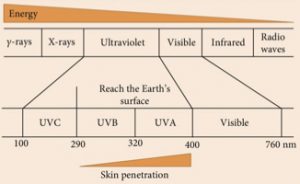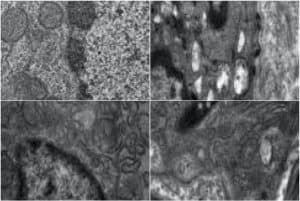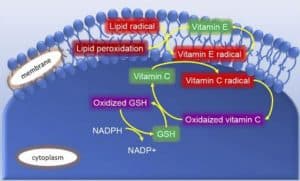Oxidative damage to cells is thought to be a causative factor in disease and aging. Aside from trauma, the process of death, at the cell level, is oxidation. The death of cells is caused by an invading molecule called a “free radical” which invades cells causing their death. These invading free radicals are part of our environment, that puff of cigarette smoke, the chemical preservatives in our foods, and water, anything that is foreign to the body can, potentially, become a free radical.
Free radicals skin production is part of our body free radicals generation whenever immune- system becomes active for example during infections or inflammatory disorders such as inflammatory acne vulgaris, which may lead to follicular epithelium damage and disruption. However, in roundworms (Caenorhabditis elegans), blocking the production of the naturally occurring antioxidant superoxide dismutase has recently been shown to increase lifespan [1].
These are atoms or molecules with an unpaired electron. A molecule is stable and harmless when the electrons are in pairs. If single, they are unstable and can potentially do damage. When an electron is taken from another molecule it becomes unstable and the attacking molecule becomes stable. This process damages various cell structures.
Free radicals are naturally occurring and an important part of biological functions such as immunity, inflammation, growth and repair and implicate processes such as aging or diseases such as hair loss, acne and photoaging. While UVA and UVB implicate in photoaging due to expression of matrix metaloproteinases, MMP-1, and increased interluekin-1-α production which leads to destructive effect of neprilysin on dermal collagen and elastin fibers, free radical insult is another expedient in the skin aging.
| Free radicals can have negative effects when they damage proteins, lipids and nucleic acids. They are normally held in balance in biological systems by antioxidant defense mechanisms. Environmental insults, infections, smoking, radiation and sunlight can also cause the formation of free radicals. |
 UVA and UVB in photoaging due to free radical generation |
Free radicals also increase production of vital hormones or chemical messengers like prostaglandins and cytokines disturbing hormonal balance and invoking inflammatory cascades, two axes whose insulting merger culminate in acne vulgaris by altering amount and composition of skin surface lipids and sebum output. It can be seen that we need free radicals to maintain health.
| Oxidative stress occurs once ROS generation overwhelms redox equilibrium, which offsets free radicals. It is these free radicals skin overproduction that is a problem. Results have demonstrated that the overexpression of catalase, an enzyme involved in the decomposition of hydrogen peroxide, increased both the average lifespan and maximum lifespan of mice by 20% [2]. |
 The skin exposed to an air pollutant: top left) unexposed normal skin, top right) an increase in the skin mitochondria, bottom left) an increase in endoplasmic reticulum, bottom right) autophagosomes are seen. |
Simplistically, when a free radical skin penetration occurs, the body and the immune system do not function optimally, different things may occur:
Since the human’s body is constantly bombarded by free radicals it is virtually impossible for the antioxidant defense system to be consistently at peak performance.
Oxidative stress occurs when there are more free radicals skin production than can be dealt with due to environmental insult, disease or malnutrition. Even exercise, because of an increase in oxygen demand and utilization, increases the formation of free radicals. However, regular exercise builds up body defense systems and protects against damage. An improper balance between formation and destruction of free radicals may play a role in degenerative disease and aging.
Antioxidants in the diet may prevent disease and deficiencies may be deleterious to fetal and childhood development.This essential nutrient not only increases the number of white blood cells it also enhances antibody formation. In skin disorders such as acne vulgaris, ROS generation is not only intrinsic to the disease and yet, in part it is the treatment modalities which must be accounted for. Antibiotics and benzoyl peroxide use in treatment of acne are associated with burdened skin cells with free radicals. The only logical solution is to help the ailing antioxidant defense system through the use of antioxidants, which may explains their use in treatment. Antioxidants are substances that act as shields or barriers to prevent the invading free radicals from doing harm to cells.
The skin is enormously sensitive to high salt intake and is one of the sites for accumulation of excess salts consequent to high salt diet. Studies indicate increased salt intake may lead to endothelial damage which is the initial injury in the development of atherosclerotic plaques. This endothelial dysfunction is independent of blood pressure values and has been demonstrated to be correlated to oxidative stress.
Garnered sodium in high salt diets has been observed to pool in the skin and stoke oxidative stress and increased free radicals burden, more evident in inflammatory skin diseases like acne vulgaris, atopic dermatitis and psoriatic skin. Endothelial dysfunction seem to be a result of blunted bioavailibility of nitric oxide, NO and its vasodilatory impact and could be abrogated by free radicals scavengers.
| Antioxidants stop the free radical damage by making the outer ring of the molecule, free radicals, stable by adding or removing electrons. Sources of antioxidants are: human body enzyme system and nutrients. Within the body, if the antioxidants are abundant enough they can neutralize free radicals oxidative damage. The antioxidant enzyme system comprised of: glutathione peroxidase, catalase, superoxide dismutase. |
 Free radicals skin insult and protective function of antioxidants |
Beta carotene, vitamin C, flavanoids, Green tea, selenium, glutatione, cysteine. Antioxidant enzyme system combine in a synergistic manner and deficiency of one cause another to be less effective. This basically means most antioxidants are specialized in function. For example vitamin E primary
function is to break lipid peroxide chains and protect against free radicals skin insult. However, there are a few antioxidants that have the ability to neutralize free radicals via different mechanisms not only in cell membrane but in interior of cells also. Melatonin and alpha lipoic acid are examples of such universal antioxidants. Alpha lipoic acid is a broad-
spectrum antioxidant capable of neutralizing free radicals in both water and oil environments.
Antioxidant micronutrients must be supplied in the diet. Fruits, vegetables and whole grains are better sources of antioxidants than pill forms, but, in general, supplementation is beneficial. A balanced diet including several servings per day of fruits and vegetables is recommended.
Severe caloric restriction has been found to reduce reactive oxidative species and to increase the life-span of rodents, possibly by promoting mitohormesis. Studies have shown that both calorie restriction and reduced meal frequency or intermittent fasting can suppress the development of various diseases and can increase life span in rodents by 30-40% by mechanisms involving stress resistance and reduced oxidative damage [3].
Free radicals skin damage explains cell death in number of circumstances. However, free radicals are naturally produced by some systems within the body and have beneficial effects that cannot be overlooked. The immune system is the main body system that utilizes free radicals. Following recommendations may help with protection against free radical damage:
1. 5-8 servings of vegetables and fruits everyday
2. Allocate 10-15 % of your daily intake to nuts
3. Reduce the stress by: Regular exercise, relaxation techniques
4. Avoid overexposure to sun, wear a sunscreen even during winter months, physical sunblockers are associated with less skin irritations and associated with less likelihood of contact dermatitis. It is of note that some studies suggest inadequacy of sunscreens especially those prepared using chemical sunblocks
5. Avoid smoking
6. Green tea and other teas are good examples of antioxidants
7. Liver and brewer’s yeast, anchovies, artichoke are good sources of alpha lipoic acid
8. Low salt diet, reduce salt intake to less than 2grams/day
Long term benefits of taking high dose of vitamins is not proven yet. Some studies suggest that the addition of antioxidants can lead to a decrease of normal biological response to free radicals and lead to a more sensitive environment to oxidation. it seems supplying body with antioxidants through a balanced diet rich in fruits, green leafy vegetables, nuts and whole grains provides a more natural way of protection against free radicals.
1. ^ Jeremy M. Van Rammsdonk, Siegfried Hekimi. “Deletion of the Mitochondrial Superoxide Dismutase sod-2 Extends Lifespan in Caenorhabditis elegans“.
2. ^ a b Schulz TJ, Zarse K, Voigt A, Urban N, Birringer M, Ristow M (2007). “Glucose restriction extends Caenorhabditis elegans life span by inducing mitochondrial respiration and increasing oxidative stress“. Cell Metabolism 6 (4): 280–93.
3. ^ http://www.ncbi.nlm.nih.gov/pubmed/16446459 Calorie restriction induces mitochondrial biogenesis and bioenergetic efficiency